SMTP 101 | Email Integration
With SMTP, emails sent through ServiceMonster go through your own email system. For example, you may be able to check within your sent emails to see what was sent out to clients, or you can receive notifications of bounced emails.
SMTP, which stands for Simple Mail Transfer Protocol, is basically a way of explaining how emails are sent. If you use ServiceMonster to send out invoices or job reminders, SMTP ensures that your business emails are going through your email server, and NOT through ServiceMonster's large email platform.
Click on a link to hop to a specific section on this page:
Setting Up SMTP
Go to "Settings".

Select "SMTP Settings".

Under "SMTP Settings", select whether you want "General Emails Only" or "For All Emails".
"General Emails Only" are all 1-on-1 emails (confirmations, invoices, etc.), but NO bulk or marketing emails.
"For All Emails" includes everything (1-on-1, bulk and marketing emails).

Under "User Settings", enter in the Username and Password. The Username is the email you want to integrate and the word is the password to that email account.
If you’d like to update the email address in your Company tab to match the one you’ve just integrated with ServiceMonster, you can check the box next to “Update Company Email”.

Under "Select SMTP Server", choose your provider from the drop-down menu (Ex. Yahoo, Hotmail, ect).

IF you can't find your Provider from the list, select "Custom Email Provider" and Google search your Provider's Server and Port information (ex: Yahoo email's port numbers).
Be sure the "Enable SSL/TLS" box is checked.
To test the SMTP Server and Port settings, click the "Test Server Settings" button; this will not check your email address or password validity, it will just check the server and port.

Under "Optional", send a test email to see whether everything is working correctly. Enter a different email address to the one you just integrated with ServiceMonster, and click the "Send Test Email" button.
Save your custom email settings by clicking on the blue "Save" button in the upper left.
Setting Up SMTP For Gmail
Setting up SMTP with Gmail may seem daunting, but it's worth it. Once it's set up you’ll be able to see emails sent through ServiceMonster the same way you’d see any email sent directly through Gmail!
Follow the above steps for setting up SMTP Settings and Select SMTP Server.
For Gmail, the password in User Settings will need to be custom generated.
First open Gmail, and click on the icon in the top right corner of the screen. Click on "Manage Your Google Account".

Click on "Security".

Scroll down to "How You Sign In To Google" and select "2-Step Verification".

Enable your "2-Step Verification" if you haven't already. Once 2-Step Verification is enabled, then use the search bar at the top to search for "App Password" and click on the result as shown:

In the create new app password box, type in ServiceMonster. Click Create

It will then generate a password for you to use.

You can write this down, or click & hold to select the password then right-click & select "Copy"

Go back to your ServiceMonster account, and manually type in the password under "User Settings". If you copied it, right-click & select "Paste".

Save your custom email settings by clicking on the blue "Save" button in the upper left.
More Information
If you’d like more information on Two-Step Verification, and more options for using it with your account, Google Help has some resources available to you:
- Google’s info site about 2-Step verification can be found at: google.com/2step
- Here is a video from Google about How to Use 2-Step Verification Without Your Phone
- Here is a video from Google about Using Apps with 2-Step Verification
Alternative Gmail/G Suite Settings
SMTP settings for those that have a custom domain email hosted by Google will need to utilize the following support articles from google.
Gmail personal settings:https://support.google.com/accounts/answer/6010255?hl=en
G suites app access settings:https://support.google.com/a/answer/6260879
Setting Up SMTP For Microsoft Office 365
From the Main Menu, click on the "Settings" tab and choose "SMTP Settings".

Under SMTP Settings, select either "General Emails Only" or "For All Emails". "General Emails Only" are all 1-on-1 emails (confirmations, invoices, etc.), but NO bulk or marketing emails. "For All Emails" includes everything (1-on-1, bulk and marketing emails).
Under User Settings, fill in your Username and Password. The Username is the email you want to integrate and the password is the password to that email account. If you’d like to update the email address in your Company tab to match the one you’ve just integrated with ServiceMonster, you can check the box next to “Update Company Email”.
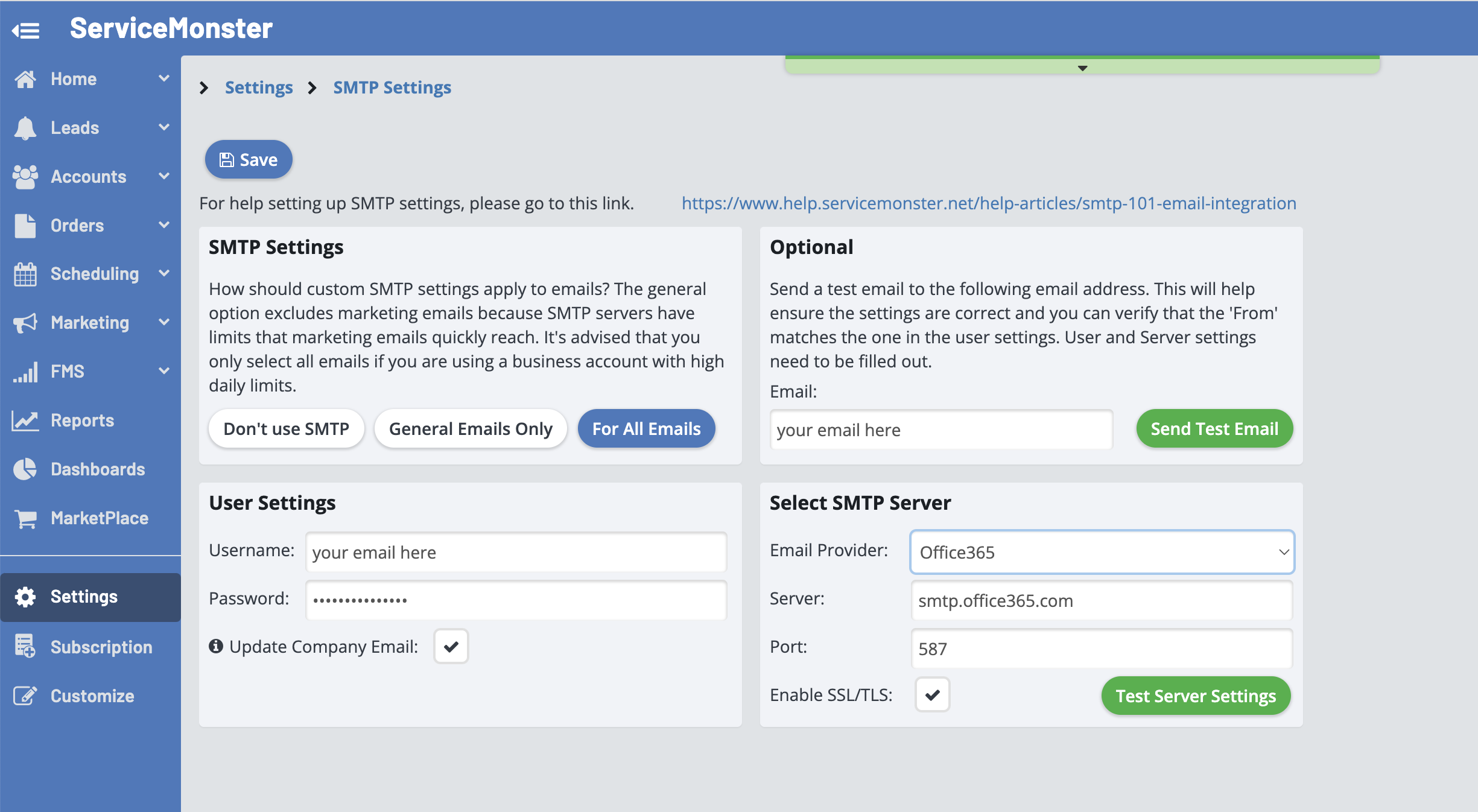
Under Select SMTP Server, choose your provider from the drop-down menu "Office365".
If you’d like to test the SMTP Server and Port settings, you can click the "Test Server Settings" button; this will not check your email address or password validity, it will just check the server and port.
Under Optional, send a test email to see if everything is working correctly. Enter a different email address to the one you just integrated with ServiceMonster, and click the "Send Test Email" button.
Save your custom email settings by clicking on the blue "Save" button in the upper left.
Unsubscribe Link
If you're set up with SMTP (to utilize your own email) then you will need to add an Unsubscribe Link at the bottom of your emails. It’s actually a law!
From the Main Menu, click on the "Settings" tab and choose "Templates".
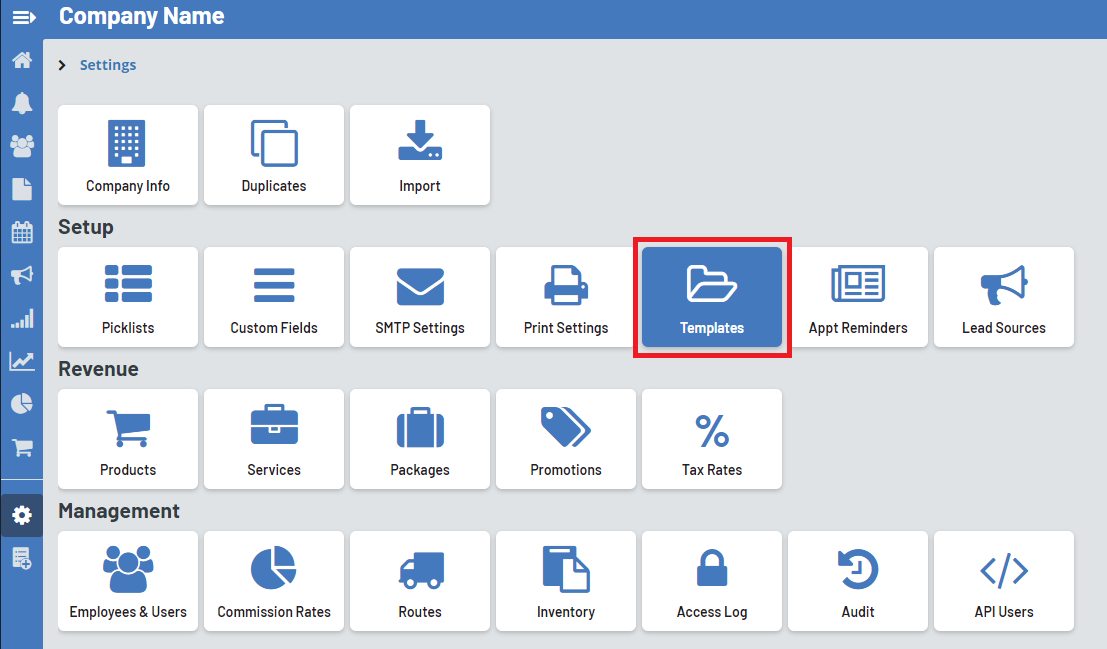
Then select "Marketing Templates".
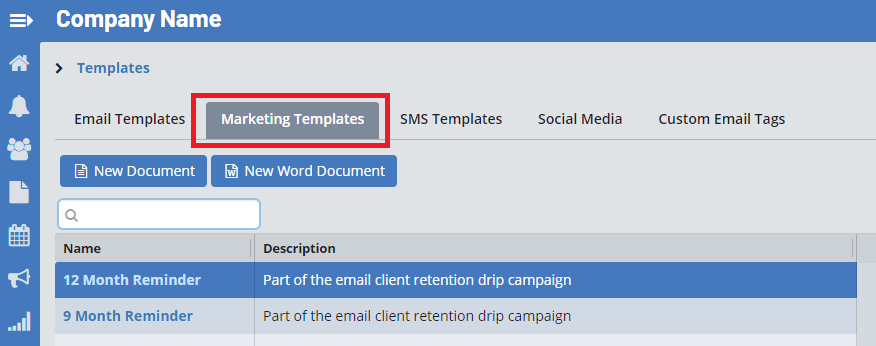
Choose the marketing template you want to use, or create a new template by clicking "New Document". We will use the "3 Month Reminder" for this example.
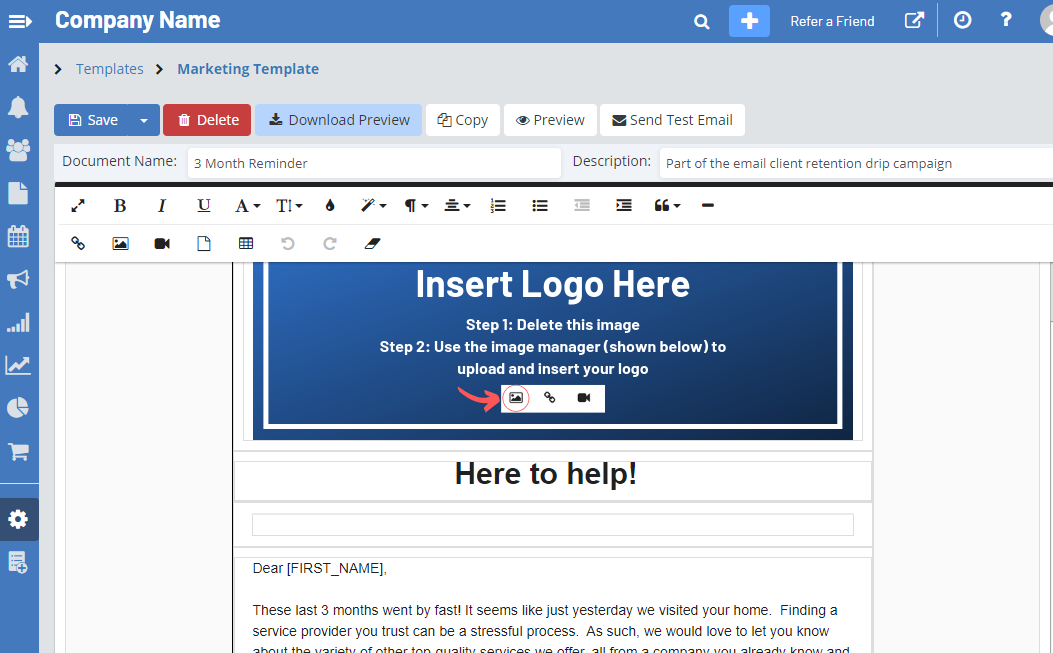
Type and/or select the text you want to use as a hyperlink.
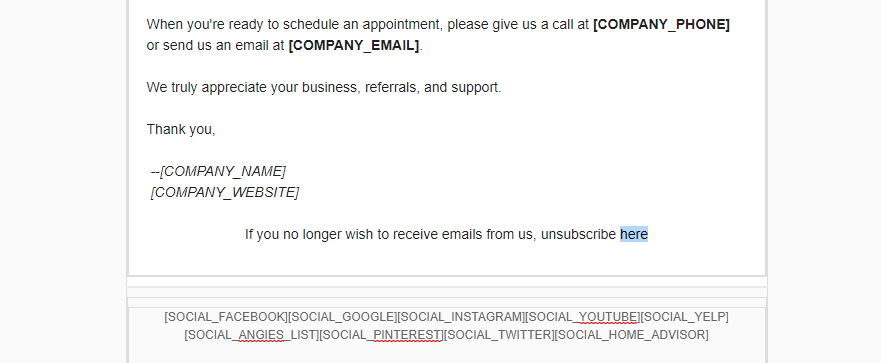
Click on the “Insert Link” icon.
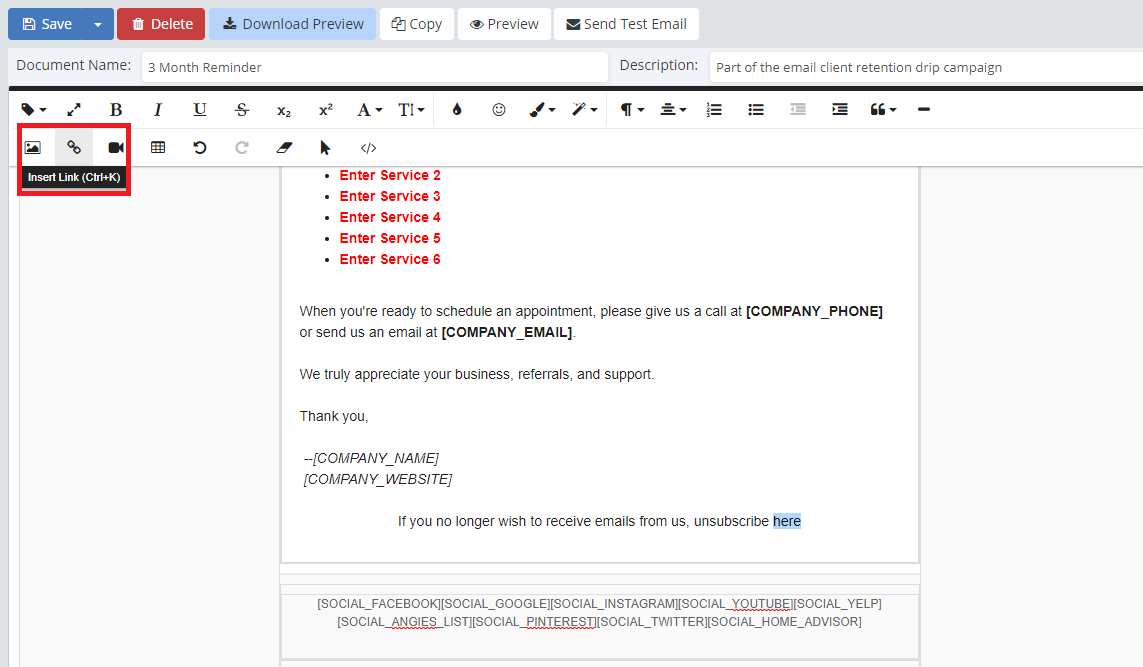
Enter the URL. This should be mailto: followed by your email address and the subject keyword to unsubscribe or remove. Sample: mailto:yourlist@yourdomain.tld?subject=remove
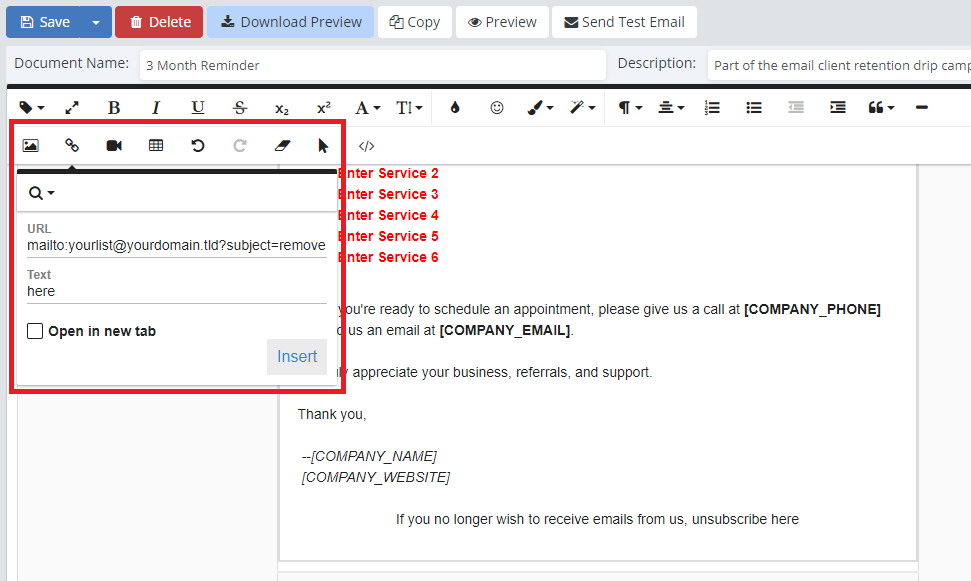
When a client clicks on this link, it will open their email with your email address and "Remove" or whatever you put as the subject keyword as the subject.
If you are using our default email settings, we will provide an unsubscribe link on every email sent through the marketing system. It will look like this example below:

SMTP Email Limitations
SMTP may limit the number of emails you can send each day.
Every outgoing SMTP mail server is guided by a provider’s email policy which includes hourly and/or daily email send limits. This policy will ultimately determine how many emails you can send each day.
You can find a list of the hourly and daily send limits for most of the major ISPs, web hosting companies and Free email address providers below.
If you try to send more email than the hourly or daily email sending limits of your mail server, you will notice errors being returned after the specified quota is met, saying something along the lines of: "You have reached your daily sending quota…"
If you surpass the daily SMTP email sending limits of your provider, you will generally have to wait 24 hours before you can send more email through that particular server.
See a list of common SMTP limits in the next section.
What to do if your mail server has limits that don’t support the size of your mailing list
If your current outgoing SMTP email server does not support your email list size or sending frequency, you have a variety of options:
1. Contact the host of your outgoing SMTP mail server(s) and ask if they have a business account that lets you send more emails each day to support your business.
2. Find a web hosting company who has daily email sending limits that meet your needs.
3. Setup your own MS Exchange Server and configure it for SMTP email delivery.
4. Instead of sending through the system, run your campaigns and select the export option to send through a third-party. Some options are MailChimp, VirticalResponse and ConstantContact.
So, while ServiceMonster allows you to send and manage email lists of unlimited size; the success of email delivery to large groups is ultimately dependent upon the sending limits set forth in the email sending policy of the SMTP mail server you are using.
ISP Email Sending Limits
Comcast Email Sending Limit– Residential customers: 1,000 emails per day– Business customers: 24,000 emails per day– 25mb per email limit Comcast email sending guidelines
Earthlink Email Sending Limit– 500 recipients per email, at 20 mb Earthlink email sending guidelines
Cox Email Sending Limit– No limits published by Cox. Cox email sending guidelines
Web Hosting Provider Email Sending Limits
GoDaddy Email Sending Limit– 250 emails per day– Option to purchase additional GoDaddy SMTP relays– 30mb per message GoDaddy email sending guidelines
RackSpace Email Sending Limit– 10,000 total recipients per 24-hour period RackSpace Email Limits
iPowerWeb Email Sending Limit– 500 emails per hour– 5,000 emails per day– 32mb per message iPowerWeb email sending guidelines
IONOS Email Sending Limit– Depends on the age of the contract IONOS Mailing Limits
Bluehost Email Sending Limit– 150 emails per hour, contact them if you need to send more. Bluehost email sending guidelines
DreamHost – 100 emails per hour. Dreamhost Email Sending Quotas
Homestead Email Sending Limit– 10 emails per secondHomestead email sending guidelines
Free Email Provider Email Sending Limits
Google Gmail Email Sending Limit– 10,000 emails a day, but this could very. Gmail email sending guidelines
Microsoft Office Outlook – Outlook notes the following: "To help protect against abuse by spammers, Outlook.com limits the number of email messages that you can send in a single day, as well as the number of recipients for a single message. For each person, Outlook.com calculates a sender “reputation”, which is based on a number of factors, including how long that person has had their account and whether recipients of their past email messages marked those messages as spam. These reputation-based limits can change depending on the volume and type of ongoing spammer attacks." Send Limits in Outlook.com
Yahoo Email Sending Limit– 500 emails per day, at most 100 recipients, each recipient counts towards the 500 day limit Yahoo email sending guidelines
AOL Email Sending Limit– "In order to better enforce anti-spam policies, AOL does not disclose the number of recipients or emails that can be sent at one time." AOL email sending guidelines
